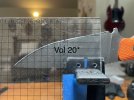I'm not familiar with the sharpening system or the knife steel, but I can tell you that
if you take alternating edge leading strokes it might be pretty tough to feel any kind of burr. I don't know if it was used that way, just saying.
I think Cliff was talking about a foil edge more than a burr. Either way I would consider his edge micro beveled.
Not everyone is a burr sharpener, it's not the only way. Some reduce as they go and some never raise much of a burr.
Most of the old instructions for oil stones specified alternating edge leading strokes and there is no mention of burrs or burr removal here...
I don't rely too much on actually feeling or even directly seeing the burr in the finishing steps. The skin on my finger pads is a bit too thick, dry & insensitive to do that at my age (early 60s). And my aging eyes have issues as well. Although under bright light, even the tiniest of burrs will usually reflect a bright spot along the edge to reveal themselves, even if my vision is a bit blurry at close inspection distance.
That's why I rely more on the cutting tests in paper to tell me if a burr of any significance is there. The little snags & slips seen in a SLOW cut into fine paper (phonebook pages, receipt paper, etc.) will reveal if it's there. And more so, if it's erratic from one pass to another, indicating the burr (or foil) is very flimsy and moving back & forth with each cut.
And a hair-shaving test done from both sides of the edge will also reveal a burr that's leaning to one side or the other. When the burr leans into the skin, it'll shave. But flip the blade over, after which the burr is leaning up and away from the skin, and it won't shave.
Edited to add:
Looked at that video link from Dan's, after replying here earlier. As the video is presented there, it looks mainly like the final refinement stage of sharpening they're demonstrating, using very light edge-leading strokes on finishing stones in a minimum of passes. Or just a light tune-up sharpening after the fact. In that sense, verifying the burr won't necessarily be important for someone familiar with the blade and sharpening it on those stones. I touched on it earlier - if the user is very familiar with the blade already and the edge is known to be within just a few strokes of being as sharp as expected, then an experienced sharpener may not be looking for the burr anyway, but instead just getting it back to functionally 'sharp' (by their own definition of that). I test edges by cutting paper, and if they meet my expectation for ease & repeatability of cutting, I don't necessarily feel a need to verify I formed a new burr. That's because I recognize how the edge cuts and how that directly compares to cutting with an edge that I did verify for a burr and then cleaned it up, which produces a certain threshold of sharpness I'm looking for. Once I see that threshold of sharpness reached, I don't feel the need to look for a burr, except to make sure it's fully cleaned up from the edge and not getting in the way of easy cutting.
I do believe it's more important to verify a burr if a new edge is being completely reground, using coarser stones.

